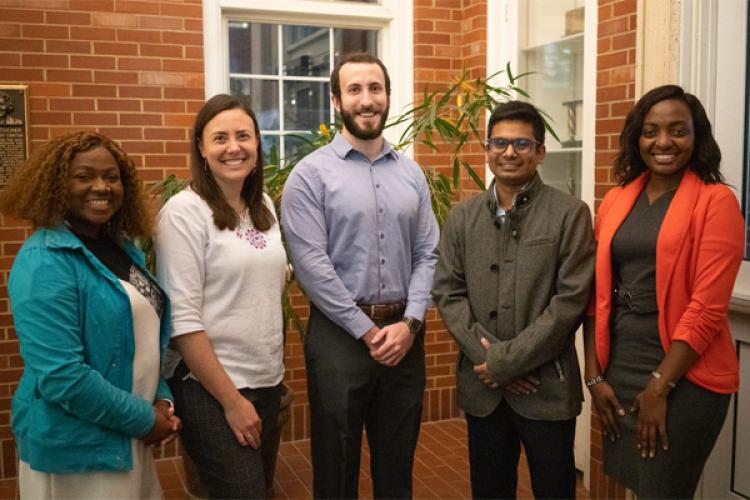
Five students win awards in Three Minute Thesis competition

Five students won awards at the Ohio University Three Minute Thesis Competition finals hosted by the Graduate College on Dec. 2.
The Three Minute Thesis Competition (3MT) was founded by the University of Queensland in 2008, with competitions now held at more than 900 institutions in 80 countries. This is the seventh year that OHIO has participated in 3MT.
Students have three minutes to present a compelling oration on their thesis and its significance. 3MT challenges students to consolidate their ideas and research discoveries so they can be presented concisely to a non-specialist audience. Participants are allowed a single PowerPoint slide and no additional props. Judging includes whether the participants clearly describe their research results, including conclusions and outcomes, while avoiding scientific jargon.
"Our OHIO graduate students are doing outstanding research, and it's an important skill for them to be able to explain their complex work for a non-expert audience," says Dr. Becky Bushey-Miller, director of communications and professional development in the Graduate College.
Fifteen students competed this year, using their three minutes to talk about their thesis or dissertation to a panel of OHIO judges. Cash prizes were given to the top three competitors: $300 for first place, $200 for second place, and $100 for third place. In addition, two People’s Choice awards of $100 were given, one for a doctoral student and one for a master student.
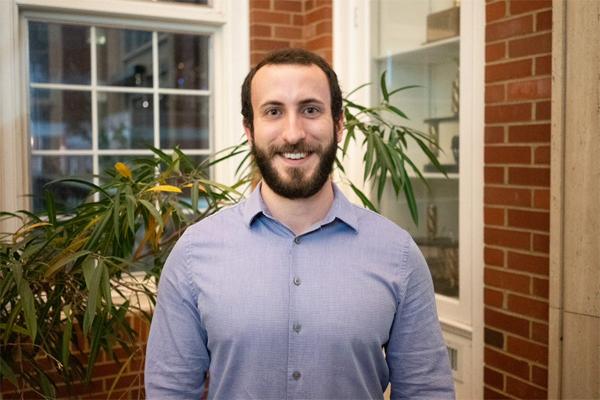
Nicholas Whitticar, doctoral student in Translational Biomedical Sciences in the Graduate College took first place for his presentation titled “Organ-on-a-Chip Platform to Study Pulsatile Insulin Secretion.”
“Insulin is secreted from pancreatic islets in distinct pulses due to alternating periods of cellular activity and rest. The resulting pattern of insulin secretion is critical for proper hormonal signaling at the liver. To force islets to secrete insulin pulses in vitro, we have created a microfluidic system that flows alternating stimulatory and inhibitory solutions over islets,” Whitticar said.
“Next, we designed 3D printed organ-on-a-chip platforms that can hold liver cells downstream of the islets. We can use this system to explore the interaction between pancreatic islets and the liver to get a deeper understanding of what goes wrong with these organs in the progression of type 2 diabetes,” he said.
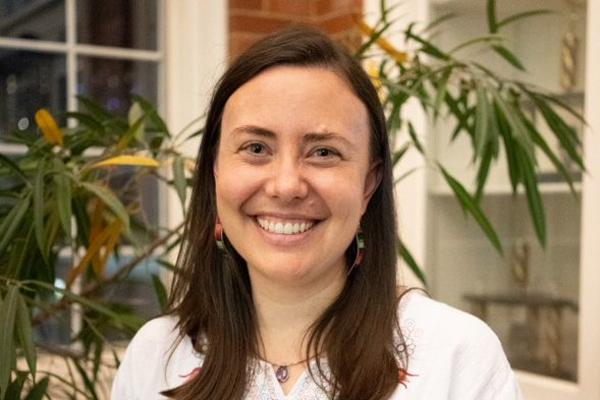
Megan Westervelt, master’s student in Communication Media Arts in the Scripps College of Communication, took second place for her work on “Convergence of Technology, Communication, and Culture in Amazonian Ecuador.”
“We have learned to survive through knowledge transferred within stories shared between generations. Yet, as human society has become more globalized, knowledge from our ancestors’ stories has often been left behind. This abandoned wisdom, however, may hold the key to our survival success as a species, so it is critical that we explore how to preserve indigenous stories, cultures, and land,” Westervelt said.
“After working with participants in the Waorani community of Dicaro, in the heart of Yasunì National Park in Amazonian Ecuador, a team of field researchers and I have explored both if and how producing digital stories and having access to sharing those stories with a global audience can provide a tool for indigenous communities to understand, communicate, and address biocultural conservation challenges in their own communities,” she added.
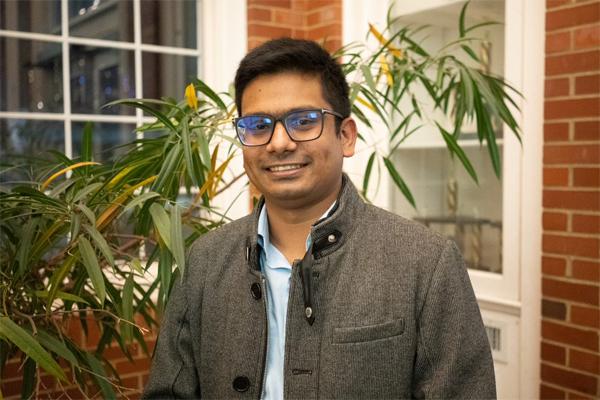
Abhijit Sukul, doctoral student in Chemistry and Biochemistry in the College of Arts and Sciences, took third place for “sRNAs, A Switch to Control Secondary Cell Wall Transition.
“All plant species form two types of cell walls. A thin and flexible primary cell wall that forms first is responsible for shaping the plant during cell growth and elongation. When the primary cell wall stops growing, a secondary cell wall forms to strengthen the plant structure. Understanding the underlying regulatory mechanisms governing primary to secondary cell wall transition is crucial for plant biology and renewable energy enrichment,” Sukul said.
“Previous research in our lab had shown that small RNAs associated with a cellulose synthase gene in barley may play an important role in the transition from primary to the secondary cell wall. I am performing an RNA sequencing analysis using an inducible secondary cell wall model in Arabidopsis thaliana to identify important small RNAs that modulate the cell wall transition and to characterize their function," he added."
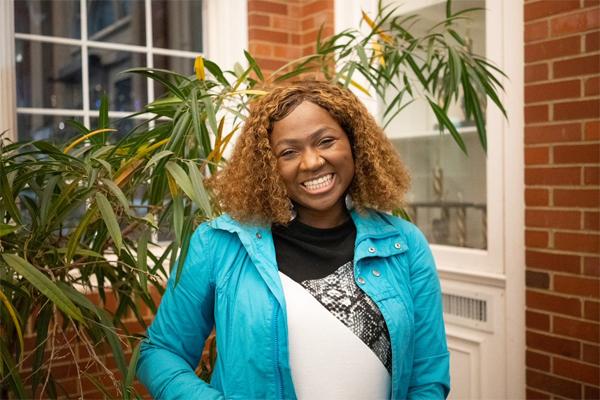
Mary-Magdalene Chumbow, doctoral student in Mass Communication/Media Arts & Studies in the Scripps College of Communication, won the People's Choice Award for a Doctoral Student for her work on “Exploring the Narratives of Survivors of Female Genital Cutting in Kenya.”
“As an African woman who was born in Cameroon, which is in Western Africa, then grew up in Kenya, an East African country, I have heard stories of different cultural practices that African women in any of the African countries that I have lived in and/or visited, face. One such practice is female genital cutting (FGC), which refers to the surgical altering or complete removal of the female genitalia,” Chumbow said.
“This proposed study seeks to understand the perspectives that FGC survivors in Kenya have towards FGC and their attitudes towards the practice. The proposed method of data collection is in-depth interviews with 15 to 20 women who have survived FGC. The study employs feminist theoretical structure and methodology to understand the perspective of and attitudes towards FGC by survivors of FGC in Kenya,” she added.
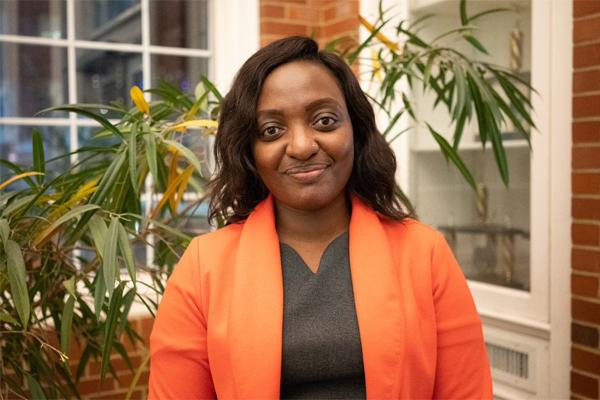
Medrine Nyambura, master’s student in Communication Media Arts in the Scripps College of Communication, won the People's Choice Award for a Master Student for her work on “Gamification of Vaccine Information.”
“Have you heard the phrase, why won't people get vaccinated so that we can go back to normal? There is tension between the two divides of those who are vaccinated and those who are not in support of vaccination,” Nyambura said.
“For this project, Gamification of Vaccine Information, we explore the nuanced conversation around those who are not in the two extremes but are on the fence on getting the vaccine,” Nyambura added.
